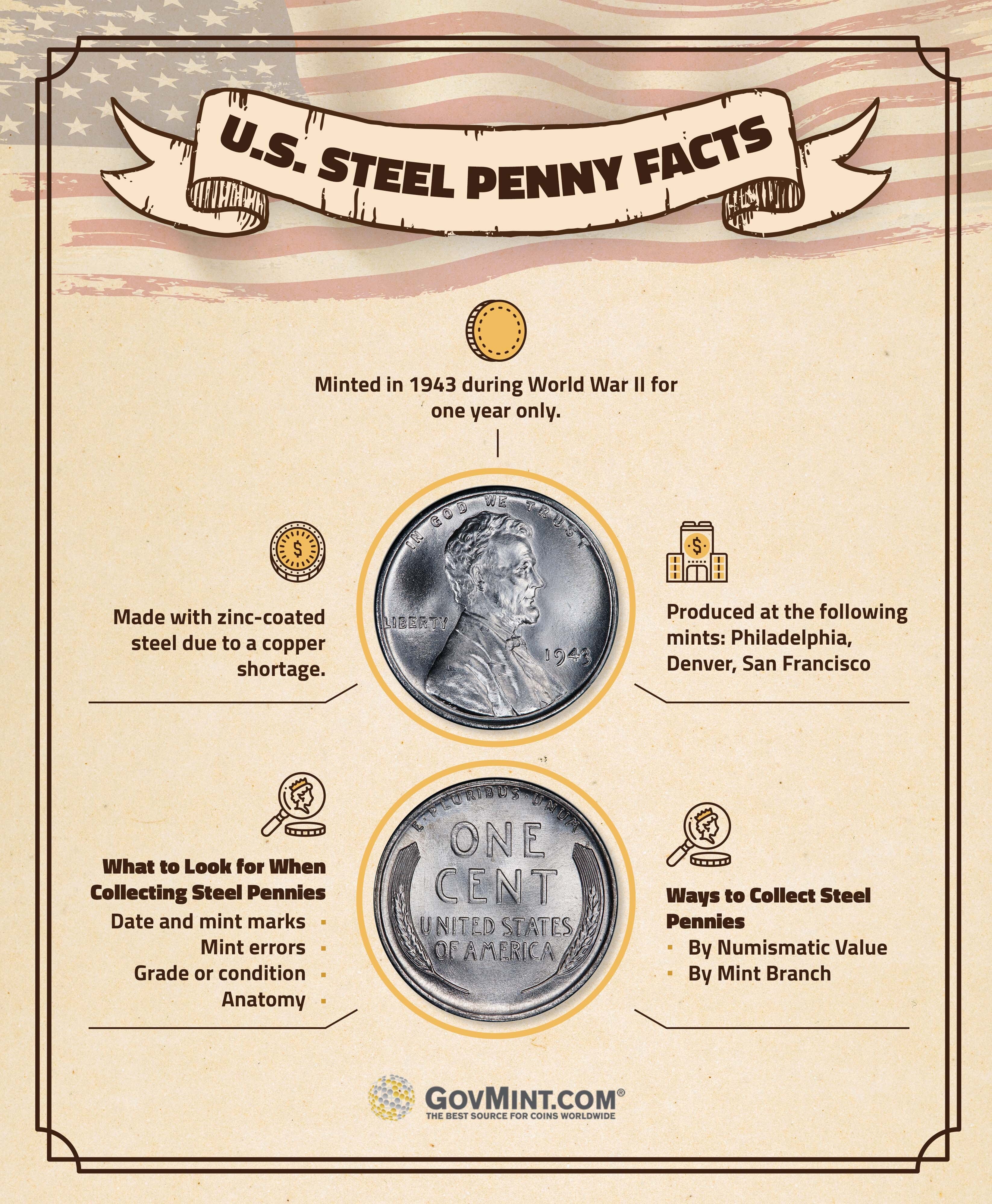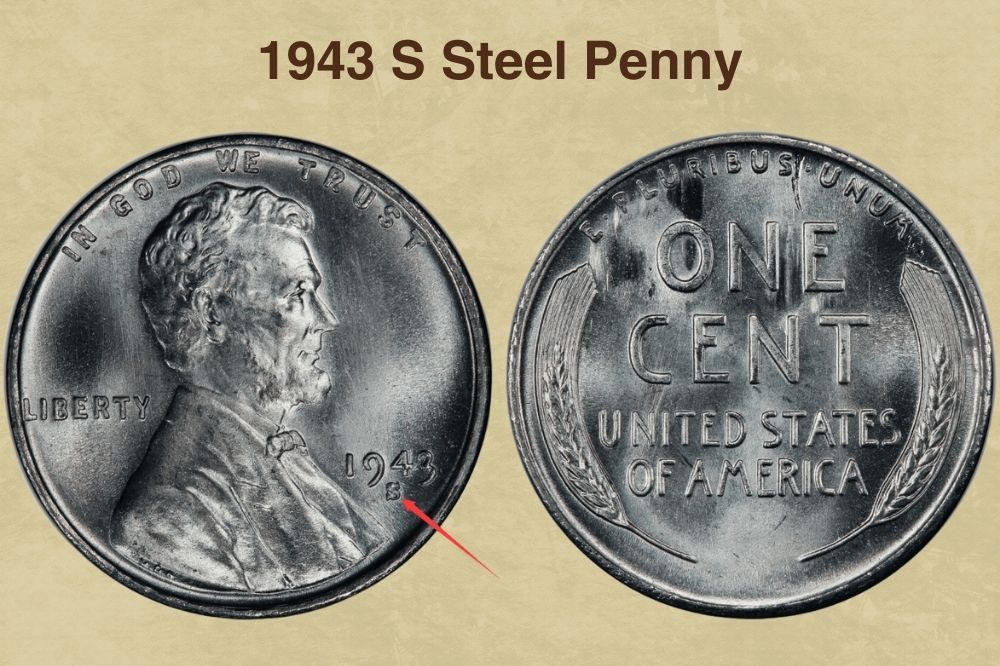Steel Penny Value: Uncover the Rare Coin’s Worth!
Steel pennies from 1943 can vary in value from 10 cents to over $100,000. Factors like rarity, condition, and mint marks significantly influence their worth.
Steel pennies hold a unique place in American numismatic history, marking a year when the U. S. Diverged from its standard materials to support war efforts. 1943 introduced the steel penny, a departure from copper, conserved for ammunition during World War II.
These coins, coated in zinc to prevent rust, now serve as a fascinating collectible item. Their value not only reflects their historical significance but also the condition and rarity of each piece. Collectors and enthusiasts seek out high-grade specimens, with some variations like the 1943 copper penny fetching even higher sums due to its extreme rarity. Understanding the nuances of these steel coins can turn a simple hobby into a rewarding pursuit of history and value.
The Origin Of Steel Pennies
In the midst of World War II, the United States needed to conserve copper for military purposes. This led to the creation of the steel penny, an emblem of wartime innovation and frugality. These unique coins reveal a story of American history and resourcefulness.
The War Effort
Steel pennies emerged as a solution to save copper for war. During the war, copper was vital for making ammunition and other essential equipment. The U.S. Mint sought alternative materials to produce pennies. In 1943, the mint introduced the steel penny to the public. These coins became an icon of the home front war effort.
Production And Characteristics
Steel pennies have distinct features that set them apart. They were made from low-grade steel coated with zinc. This gave them a shiny, silver appearance when new. Over time, they often tarnished to a dark gray color. Here are some characteristics:
- Composition: Zinc-coated steel
- Weight: 2.7 grams
- Diameter: 19 mm
Despite their short production span, steel pennies marked an era of adaptability. They stand as a testament to the United States’ commitment to the war effort.

Credit: www.govmint.com
Identifying Steel Pennies
Steel pennies are a fascinating part of U.S. coin history. Minted during World War II, these coins are unique. Collectors often seek them for their historical value. Knowing how to identify a steel penny is crucial for any collector.
Key Features
Steel pennies stand out from other coins. Look for these features:
- Magnetic properties: Steel pennies stick to magnets.
- 1943 date: Only minted in this year.
- Silver-like appearance: Their color is distinct from copper pennies.
- No mint mark: Pennies from Philadelphia lack a mint mark.
Common Misidentifications
It’s easy to mistake other coins for steel pennies. Be cautious:
- Worn silver coins: Can look similar but are not magnetic.
- Galvanized coins: These are altered coins, not original steel pennies.
- 1948 pennies: Sometimes mistaken due to wear on the date.
Rarity And Collectibility
The allure of the Steel Penny lies in its unique history and scarcity. These coins, minted during a time of war, are a symbol of American resilience. Collectors prize Steel Pennies for their rarity and the stories they hold. Let’s delve into what makes some Steel Pennies more rare and collectible than others.
Factors Influencing Rarity
- Mintage Year: The 1943 penny is most common.
- Condition: Uncirculated coins are rarer.
- Mint Errors: Mistakes increase value.
Steel Pennies from 1944, often mistaken as counterfeits, are incredibly rare. These were erroneously struck on leftover steel blanks. Coins in pristine condition, with no signs of wear, also command higher prices. Errors, like double dies or off-center strikes, add to a penny’s rarity.
Most Sought-after Variants
| Variant | Why Collectors Want It |
|---|---|
| 1943 Bronze/Copper | Accidental strike, very few exist |
| 1944 Steel | Supposed to be minted in copper |
| 1943-D Boldly Doubled Mintmark | Visible error, highly prized |
The 1943 bronze/copper pennies are the stars among Steel Penny variants. Struck on the wrong material, they are exceptionally rare. The 1944 Steel Penny, a leftover from the previous year’s steel planchets, also stirs collector excitement. Errors like the boldly doubled mintmark on the 1943-D penny make it a must-have for enthusiasts.
Current Market Trends
Steel pennies have a unique place in numismatics. Current market trends show a rising interest in these historical coins. Collectors and investors keep a close eye on their value. Let’s explore what’s happening in the market.
Recent Auction Records
Auction results are a great indicator of value. They show what people will pay for steel pennies. Recent auctions have set records. Here are some notable sales:
- 1943-S Lincoln Cent, sold for over $1,000
- 1943-D Lincoln Cent, pristine condition, fetched $2,500
- Rare error coins, such as the 1943 copper penny, reached sky-high prices
Predictions For Future Value
Steel penny value may keep rising. Here are reasons:
| Factor | Impact on Value |
|---|---|
| Historical Significance | High interest from collectors |
| Condition | Better condition, higher prices |
| Rarity | Rare editions like error coins may gain value |
Experts believe steel penny value will grow. They are right. Collecting trends and historical importance support this.
Valuing Your Steel Penny
Collectors often seek unique pieces of history, like the steel penny. The steel penny holds a special place in American numismatics. It is a symbol of the era it was made. It is important to know the worth of your steel penny. Proper valuation can turn a simple coin into a prized possession.
Condition Grading
Condition greatly affects a steel penny’s value. Coins come in varying states, from mint condition to heavily worn. Experts use a scale known as the Sheldon Coin Grading System. This system ranges from ‘Poor’ (P-1) to ‘Perfect Uncirculated’ (MS-70).
- Uncirculated (MS) – No wear from circulation.
- Extremely Fine (XF) – Slight wear on high points.
- Very Good (VG) – Major features clear, but flat.
- Good (G) – Worn down but design visible.
- Poor (P) – Barely identifiable; heavy wear.
Collectors favor coins closer to MS-70. These bring higher prices. A table can help illustrate this:
| Grade | Condition | Value Range |
|---|---|---|
| MS-70 | Perfect condition | Highest value |
| MS-60 | No wear, minor marks | High value |
| VG-8 | Wear on high points | Moderate value |
| G-4 | Design visible, very worn | Lower value |
| P-1 | Heavy wear, barely identifiable | Lowest value |
Professional Appraisals
An expert appraisal can give the best value estimate. Professional appraisers use experience and tools to grade coins. They examine the coin’s condition, rarity, and historical significance. Appraisers will provide a certificate of authenticity. This confirms the coin’s grade and value.
Seek reputable professionals for appraisals. They should be members of numismatic societies. These include the American Numismatic Association (ANA) or Professional Coin Grading Service (PCGS).
An appraisal might cost money. It can increase a coin’s value significantly. It assures buyers of the coin’s condition and worth.

Credit: www.coinvaluechecker.com
Preserving Steel Pennies
Collectors know the importance of keeping steel pennies in top condition. These unique coins, minted in 1943, hold historical value. Proper care ensures their longevity and maintains their worth. Let’s explore the best ways to preserve these metallic treasures.
Storage Solutions
Choosing the right storage is crucial for steel pennies. Here are top solutions:
- Albums: Safe and display-friendly.
- Flips: Protective and easy to handle.
- Tubes: Ideal for bulk storage.
- Boxes: Best for large collections.
Controlled environments prevent damage. Keep your coins in a dry, cool place.
Preventing Corrosion
Corrosion is a steel penny’s enemy. Follow these steps to avoid it:
- Handle with care: Always use gloves.
- Minimize exposure: Limit air and moisture contact.
- Use desiccants: Silica gel absorbs dampness.
- Clean properly: Only when necessary, with the right materials.
Regular checks help catch early signs of wear or corrosion.
Selling Your Steel Penny
If you’re ready to sell your steel penny, you’ve chosen a fascinating moment in numismatic history to engage with. Steel pennies carry a unique story from 1943, the year when copper was crucial for wartime efforts. Your coin might not only hold historical value but could also fetch a nice price. Let’s explore how to sell your steel penny effectively.
Finding The Right Venue
Choosing where to sell your steel penny is key. You want a place that offers visibility to serious collectors. Here are some popular options:
- Online Auctions: Sites like eBay connect you with a global audience.
- Coin Shows: Local or national shows attract collectors ready to buy.
- Coin Dealers: Professional dealers understand the true value of your penny.
Maximizing Your Sale
To get the best price, present your steel penny well. Clean it without damaging its patina. If you have a mint-condition coin, consider getting it graded. A higher grade means a higher price.
| Condition | Value Impact |
|---|---|
| Poor | Low value |
| Fine | Medium value |
| Mint | High value |
Document your penny’s history. Include any certificates or provenance you have. This will assure buyers of its authenticity and could boost your sale price.
Legal Considerations
When collecting or selling steel pennies, legal aspects are crucial. It’s important to stay informed on regulations to ensure transactions are legitimate and lawful.
Regulations On Sale
Steel penny trade involves specific rules. These ensure the market’s integrity. Buyers and sellers must comply with state and federal laws.
- Authenticity: Only sell genuine coins.
- Disclosure: Reveal any coin modifications.
- Tax: Report sales when required.
Counterfeit Coins
Counterfeits affect steel penny values. It’s illegal to sell fake coins as real ones. Spotting fakes requires attention to detail.
| Real | Fake |
|---|---|
| Magnetic properties | No attraction to magnets |
| Consistent stamping | Blurred or double images |
| Correct weight | Weight varies |
Report counterfeit coins to authorities. This helps protect the hobby and market value.
:max_bytes(150000):strip_icc()/US0001-Lincoln-Wheat-1943-D-5746485d5f9b58723d38c685.jpg)
Credit: www.thesprucecrafts.com
Frequently Asked Questions
How Much Are Steel Pennies Worth?
Steel pennies from 1943 typically range in value from 10 to 50 cents for circulated grades. Uncirculated examples can fetch up to $10 or more, depending on their condition. Rare errors, such as those struck on bronze, are significantly more valuable, often reaching into thousands of dollars.
Is A 1943 Penny Worth $1,000,000?
A 1943 penny typically isn’t worth $1,000,000; most are valued at 10 to 50 cents. However, a rare copper version from that year has sold for over $100,000.
How Rare Is A 1943 D Steel Penny?
The 1943 D steel penny is relatively rare, especially in pristine condition. Its scarcity is due to limited production during World War II. Collectors often seek this unique coin, making it a valuable find.
How Much Is A 1944 Steel Penny Worth?
A 1944 steel penny’s value can range significantly, from around 75 cents for common conditions to over $100,000 for those in pristine condition. Rarity and condition greatly influence its worth. Collectors highly seek after these unique coins, making their market value quite variable.
Conclusion
Understanding the value of steel pennies can be quite rewarding for collectors and enthusiasts alike. With their rich history and varying worth, these unique coins offer a glimpse into America’s past. Remember to assess their condition and rarity for a true estimation of value.
Embrace the hunt for these metallic treasures, and you may just find a piece of history in your hands.

